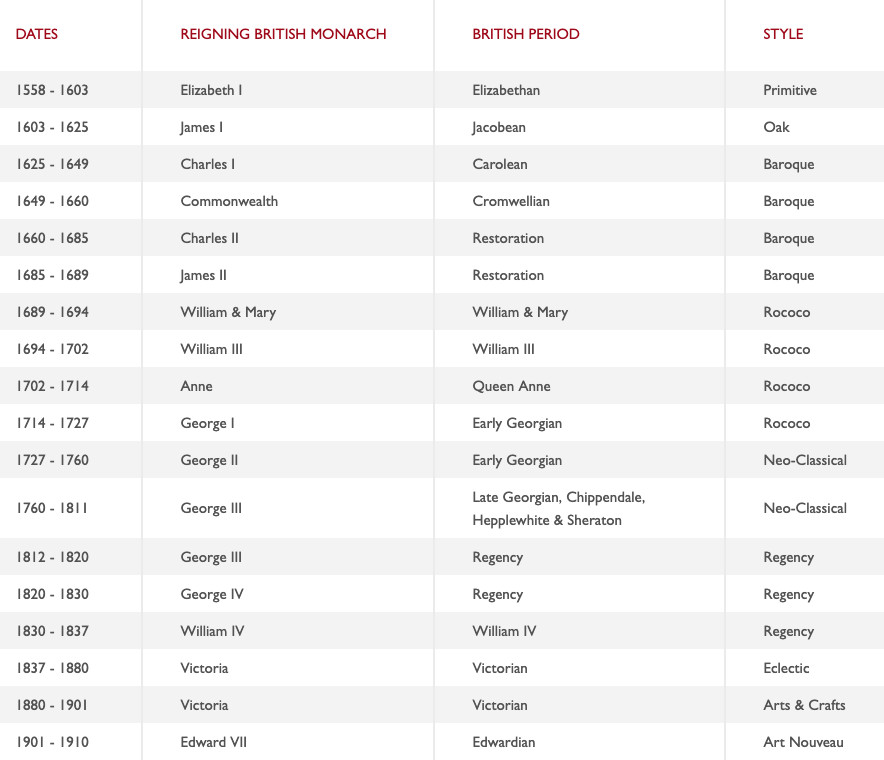Have you ever wondered just what George II or Chippendale period actually mean. Many dealers and enthusiasts refer to furniture and works of art by which period they are from without actually divulging even roughly what year that means the article is from. Now that is fine if talking to a fellow dealer or even somebody with an in depth knowledge of history, but then what about an ordinary man or woman on the street. How are they meant to know that Chippendale Period means around 1760 or that Regency Period means 1810 to 1837? Hopefully the following information will be a valuable resource to anybody trying to decipher a description they have been given or even anybody just trying to learn more about dates and styles of furniture.


Chippendale Furniture
English cabinetmaker Thomas Chippendale was a master designer who achieved worldwide fame and Chippendale furniture became one of the outstanding styles of the 18th century. Early pieces have cabriole legs with ball and class feet which have been referred to as French inspiration with English sturdiness. Chippendale style furniture was generally made of mahogany although walnut, cherry and maple were used for less expensive pieces. The furniture was extremely well built and many pieces have remained in excellent condition and can still command a high price today. Generally only the finest fabrics were used for the upholstery and were rich and strong in colour although in later years they became more subtle.
Styles were characterized by rich carvings including swirls, leaves and sometimes shells. The popularity of oriental design in Europe prompted Chippendale to use oriental motifs on elaborately decorated lacquered furniture
There was a wide range of furniture produced in the Chippendale style including tables, chairs, desks, mirrors and high boys.
It is easy to confuse Chippendale and Queen Anne style wing chairs – the difference is in the construction of the arms with the Chippendale arms rolling horizontally compared to the Queen Anne arms which rolled vertically and turned outward.
Many reproductions of the Chippendale style were produced around 1900 during the late Victorian period and whilst these are antiques in their own right they do not have the finely crafted details found in the early Chippendale style pieces.
Even today, the Chippendale influence is found in formal furniture design and manufacturing including the use of cabriole legs and claw-and-ball feet.
Regency Furniture
Prince George became Regent from 1811-1820 – this was a period of classical furniture. Regency furniture was the neoclassical antique style mixed with empire style and the later Georgian style of furniture, elaborate and ornate.
The regency style of furniture carried on through William IVs reign but introduced a few more curves and some elegant decoration. It became fashionable to copy the classical Roman and Greek furniture incorporating lion’s heads, winged griffins and Roman Gods. The settee returned to a couch with scrolled ends supported by a sphinx head on lion’s legs.
Mahogany was still used by most furniture makers and brass was used for decoration with rosewood and zebrawood veneers used for a striking look. French polishing came into vogue around 1810 and allowed for smoother, shiner finishes.
During the Regency period, it became fashionable to decorate walls with paintings which led to lower pieces of furniture being introduced. Tallboys disappeared and bookcases and cabinets became smaller.
Victorian Furniture
Victorian furniture is still popular today and is easily available. There was plenty of furniture produced – during the latter years machinery had begun to take over and mass amounts of Victorian furniture was produced to meet the demands of the middle class people as it became desirable to have a home laden with furniture to show your status to your peers.
Mahogany and rosewood were the most popular woods to produce imposing furniture with plenty of curves, rounded corners and elaborate decorations. The furniture was solidly built, well constructed and the wood generally unvarnished. Renowned cabinet makers Morris and Co became producing simple designed cabinets and sideboards which were painted with scenes of medieval fantasy. Iron began to make its appearance in the early Victorian age, particularly in bedroom furniture.
Early Victorian furniture followed the Regency trend of curved backs and some scrolled decorations. However, the clean Grecian lines of the Regency period were out of favour by 1835 when everyone wanted furniture that was showier with plenty of curves. Mid Victorian furniture was more, shiny with upholstery becoming a main factor in design and as comfort became more important, easy chairs, sofas and dining chairs with padded seats were introduced. Mirror back chiffoniers/sideboards with carved pediments and lots of storage below were popular as were card tables.
In the late Victorian times, England witnesses the rise of the art nouveau movement in design with furniture design pioneered by Charles Rennie Mackintosh and Hugh Baillie Scott.
Edwardian Furniture

This style of furniture was names for King Edward VII. It was mainly reproductions of older styles which were mass produced as machinery was used in full force. Cabinet makers realized that earlier designs were outselling new pieces as second hand (antique) furniture became very fashionable.
Art Nouveau furniture remained in high demand with people liking the curving, elongated lines and leaf and flower motifs. The Chippendale and Heplewhite styles were also very popular.
The Craftsmanship of this era was extremely good and some of the earlier designs were adapted to suit modern living and to make them more comfortable. Mahogany continued to be popular but walnut, satinwood and oak began to be introduced.
Most dovetail joints were now cut by machine and most pieces were veneered. Good quality metal ware began to be used for decoration.
Bedroom suites and dining furniture became very popular. Bedroom suites were usually simple in design and normally had beveled mirrors and constructed with hardwood linings and backboards. Dining room furniture was usually wind out tables with turned or cabriole legs and sets of chairs in a matching style.

 MENU
MENU















